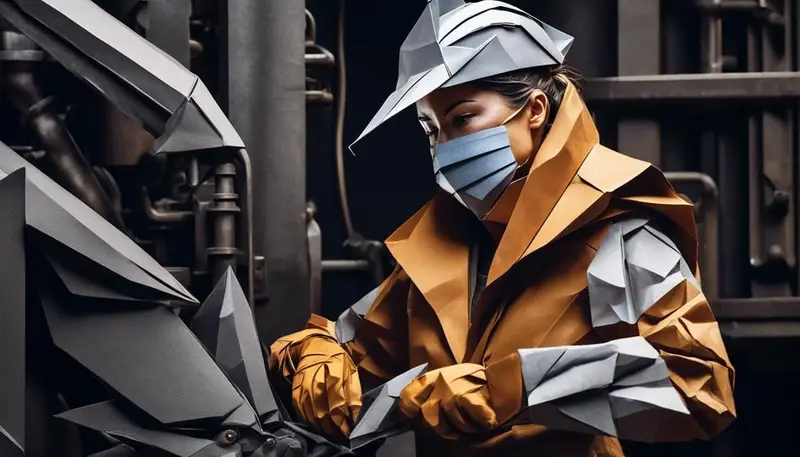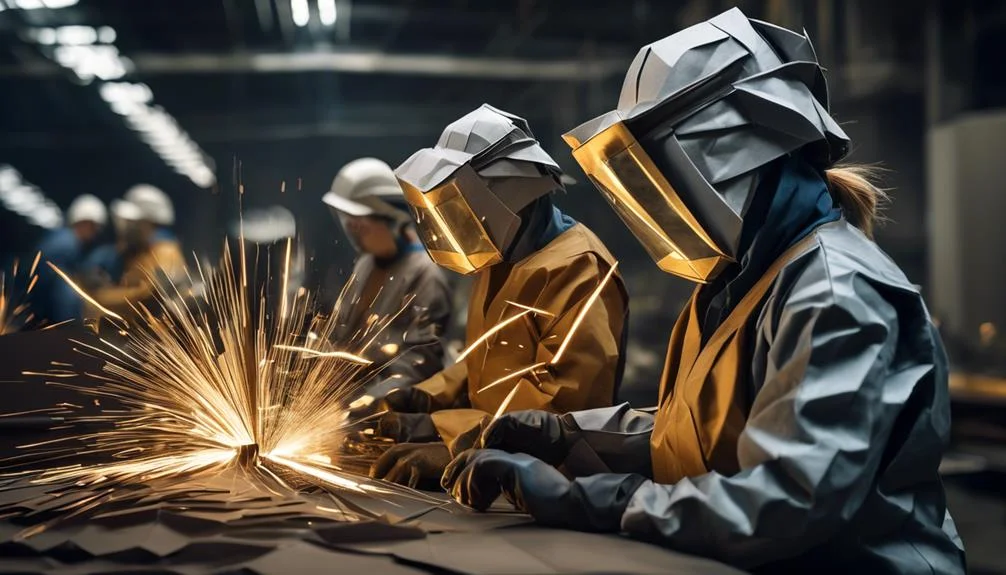Takeaways:
- Female welders challenge gender stereotypes and inspire change in the industry.
- Access to opportunities and support for women in welding is increasing, promoting inclusivity and equality.
- Job satisfaction for female welders goes beyond conventional metrics and includes artistic expression.
- Female welders face physical demands and challenges but can overcome them with determination and support.
| Pros of Being a Female Welder | Cons of Being a Female Welder |
|---|---|
| Accessibility to Tight Spaces | Physical Demands of the Job |
| Unique Perspective in Creativity | Health Risks from Fumes and Materials |
| Growing Demand in a Male-Dominated Field | Challenges in a Male-Dominated Field |
| Competitive Salary Potential | Work-Life Balance Concerns |
| Opportunities for Advancement | Limited Access to Female-Specific Resources |
| Sense of Job Satisfaction | Exposure to Harsh Working Conditions |
| Independence in the Workplace | Risk of Injury |
| Variety in Work Environments | Stigma and Social Perceptions |
| Travel Opportunities | Limited Representation in Leadership Roles |
| Networking and Community Support | Navigating Career Growth |
Pros of Being a Female Welder
- Accessibility to Tight Spaces: Women often can access confined spaces more easily due to their physique. This ability allows them to handle specialized welding tasks that require working in narrow or restricted areas, which might be less accessible to their male counterparts. This skill is particularly valuable in industries like shipbuilding or aerospace, where welding in tight spaces is common.
- Unique Perspective in Creativity: Welding, being as much an art as it is a skill, benefits from diverse creative perspectives. Female welders may bring unique approaches and ideas to the table, enhancing the quality and design of welding projects. This diversity in thought and creativity can lead to innovative solutions and improvements in welding techniques and outcomes.
- Growing Demand in a Male-Dominated Field: As welding is traditionally male-dominated, there’s a growing demand for female welders to diversify the workforce. This demand can lead to more opportunities for women in terms of employment, career advancement, and unique roles within the industry. Companies seeking to balance their workforce may offer incentives and support for female welders.
- Competitive Salary Potential: The welding industry offers competitive salaries, and as demand grows for skilled welders, including women, the potential for earning a good income is significant. Women entering the field can expect to earn wages comparable to their male counterparts, especially in sectors where skill and expertise are highly valued.
- Opportunities for Advancement: As the industry seeks to diversify, women in welding have increasing opportunities for career advancement. This can include leadership roles, specialized projects, and mentorship positions. Women with a passion for welding can climb the career ladder, breaking stereotypes and setting new standards in the industry.
- Sense of Job Satisfaction: Many welders find great satisfaction in their work, and women in the field are no exception. The ability to work on a variety of projects, see the tangible results of one’s labor, and contribute to significant constructions or products can be highly rewarding.
- Independence in the Workplace: Welding offers a high degree of independence. Female welders can enjoy working autonomously, often with the freedom to manage their projects and make critical decisions. This level of autonomy can be empowering, especially in a field where precision and expertise are highly valued.
- Variety in Work Environments: The field of welding offers diverse work environments, from indoor fabrication shops to outdoor construction sites. This variety ensures that the work is never monotonous and can be appealing to women who enjoy dynamic and changing work settings.
- Travel Opportunities: Welding skills are in demand globally, offering female welders the opportunity to travel for work. This can be an attractive aspect of the job for those who enjoy experiencing new places and cultures while practicing their trade.
- Networking and Community Support: There are growing networks and communities supporting women in trades like welding. These communities provide support, mentorship, and networking opportunities, helping female welders to connect, share experiences, and grow professionally.
Cons of Being a Female Welder
- Physical Demands of the Job: Welding is physically demanding, requiring strength and endurance. Long hours in standing positions, handling heavy equipment, and performing repetitive tasks can be challenging. Women in this field may need to consistently maintain physical fitness and endurance to manage these demands effectively.
- Health Risks from Fumes and Materials: Welding exposes workers to fumes and materials that can pose health risks, including respiratory issues and skin problems. Female welders, like their male counterparts, must be vigilant about safety practices and protective gear to minimize these risks.
- Challenges in a Male-Dominated Field: Despite increasing acceptance, women in welding can still face challenges in a predominantly male industry. This may include overcoming stereotypes, biases, or feeling the need to prove their skills and capabilities more than male colleagues.
- Work-Life Balance Concerns: The demanding nature of welding, with potential for long or irregular hours, can pose challenges for work-life balance. This can be particularly challenging for women who may have additional family or caregiving responsibilities.
- Limited Access to Female-Specific Resources: While the industry is adapting, there may still be limited access to resources specifically geared toward female welders, such as appropriately sized protective gear or female-focused training and mentorship programs.
- Exposure to Harsh Working Conditions: Welding often involves working in harsh conditions, including extreme temperatures, noisy environments, and outdoor settings with varying weather conditions. These elements can make the job challenging, requiring resilience and adaptability.
- Risk of Injury: The nature of welding work carries a risk of injury, from burns to eye damage. Women in this field must be constantly cautious and adhere strictly to safety protocols to prevent accidents.
- Stigma and Social Perceptions: Female welders may encounter social stigma or misconceptions about their choice of profession. This can range from skepticism about their abilities to challenges in finding a supportive community outside of work.
- Limited Representation in Leadership Roles: While opportunities are growing, women are still underrepresented in leadership roles within the welding industry. This lack of representation can make it more challenging for female welders to find role models and mentors.
- Navigating Career Growth: As the industry evolves, women in welding may need to navigate their career paths more strategically to overcome potential barriers and biases. This can involve continuous skill development, networking, and advocating for equal opportunities and recognition in the workplace.
Breaking Industry Stereotypes
In the realm of welding, a profession traditionally dominated by men, female welders are shattering the glass ceiling by disproving long-held gender stereotypes. Their presence in the industry is not only breaking down barriers but also expanding the notion of what women can achieve in technical and physically demanding fields. As they navigate through the challenges and biases, female welders demonstrate that skill and capability are not determined by gender, thereby inspiring a cultural shift within the workplace.
Female welders serve as role models, encouraging other women to consider careers in trades that were once deemed unsuitable for them. This shift is critical for fostering a more inclusive and diverse work environment. By challenging and changing the antiquated perceptions of gender roles, these trailblazers are paving the way for future generations of women to pursue their passions in welding or any other field without facing the same limitations.
Moreover, for the women who join the ranks of welders, mastering this craft is empowering. It instills a robust sense of confidence and self-esteem, reinforcing the understanding that their potential is boundless. The impact of female welders extends beyond the individual; it’s a progressive step towards a more equitable and skilled workforce.
Access to Growing Opportunities

The surge in demand for skilled welders has opened a plethora of opportunities for women in this traditionally male-dominated field. As industries evolve and the need for diverse talents heightens, the welding profession is increasingly becoming an attractive career choice for women seeking stable and rewarding employment. Female welders now have unprecedented access to a variety of roles that promise not only competitive pay but also the chance for career growth and the ability to make significant contributions to the field.
Here are some key benefits that female welders can look forward to:
- Equal Employment Opportunities: Companies are actively recruiting women, promoting a more gender-balanced workforce.
- Competitive Compensation: Attractive salaries reflect the demand for skilled welders and the value placed on female participation in the industry.
- Career Advancement: There is a clear path for professional development and leadership roles for women in welding.
- Supportive Networks: Mentorship programs and women-centric welding communities offer support and facilitate career progression.
These developments represent a positive shift towards inclusivity and equality, bringing down barriers and empowering women to excel and innovate in the welding industry.
Unique Job Satisfaction
The experience of job satisfaction for female welders often transcends conventional metrics due to the distinct nature of their achievements in the field. By challenging gender norms, they not only carve out a niche for themselves but also pave the way for others, instilling a profound sense of accomplishment.
Moreover, welding offers avenues for artistic expression, allowing for an infusion of creativity into their technical work.
Sense of Accomplishment
Achieving mastery as a female welder offers a profound sense of accomplishment, challenging gender norms and fostering personal empowerment in a traditionally male-dominated profession. The intricacies of welding, combined with the physical and mental demands, make for a highly skilled trade where expertise is respected and celebrated. Women in this field often experience a distinctive satisfaction from not just performing their job well, but also from breaking through societal barriers.
Mastering the welding craft emphasizes capability over gender, proving that skill is not gender-specific.
Overcoming stereotypes boosts confidence and self-esteem, contributing to workplace positivity.
The empowerment from personal growth in a non-traditional role enriches job satisfaction.
Being a trailblazer in the industry reshapes perceptions and opens doors for future female welders.
Challenging Gender Norms
Challenging gender norms within the welding industry not only enhances job satisfaction for women but also paves the way for a more equitable and dynamic workforce. Women welders break traditional gender roles, thereby inspiring future generations and shifting industry stereotypes and biases. Their presence introduces fresh perspectives, fosters innovative problem-solving, and contributes to advancements through a distinct female lens.
The growing demand for skilled female welders is met with competitive salaries and increased recognition, which promotes a diverse and inclusive working environment. Networking groups, mentorship programs, and support for career advancement fortify the welding community. Moreover, female welders serve as influential role models, encouraging young girls and women to pursue their passions and dismantle long-standing barriers and stereotypes in traditionally male-dominated fields.
Artistic Expression Opportunities
Welding transcends its industrial roots to offer female welders a canvas for artistic expression, providing a unique avenue for job satisfaction through creativity and innovation. When women step into the welding booth, they’re not just joining a workforce; they’re entering a world where metal can be transformed into art. The melding of skill and imagination opens doors to an array of artistic endeavors that can be both personally fulfilling and professionally rewarding.
- Welding allows for self-expression, turning functional objects into works of art.
- A fresh perspective from female welders can lead to novel artistic welding techniques.
- The craft offers a powerful sense of empowerment through the creation of metal sculptures.
- Inspiring others by breaking gender stereotypes enriches the welding community with diversity.
Workplace Cultural Challenges

In the realm of welding, female professionals often contend with ingrained workplace cultural challenges that stem from persistent gender roles and stereotypes. These social constructs can manifest as biases and discrimination, subtly interwoven into daily interactions and expectations within the workplace. For many female welders, overcoming these preconceived notions requires constant effort and resilience. They may feel the pressure to work harder to prove their capabilities and to challenge the gender biases that question their place in a traditionally male-dominated field.
The social aspect of work can also pose significant hurdles. Female welders might struggle with isolation and find it difficult to establish camaraderie with male colleagues. Exclusion from informal networking and group activities that foster team unity can further deepen the sense of alienation. Furthermore, the lack of consideration for women’s specific needs, such as the availability of appropriately sized personal protective equipment, highlights the industry’s slow pace in adapting to a gender-diverse workforce.
These cultural challenges underscore the importance of fostering an inclusive work environment. Addressing these issues head-on is crucial for the welding industry to evolve and fully embrace the contributions of female welders.
Physical Demands of Welding

The physicality of a career in welding necessitates robust health, considerable strength, and enduring stamina, aspects that can pose unique challenges for female welders. While welding is undeniably a physically intensive occupation, it is essential to recognize that individuals of any gender can succeed in this field with the right preparation and mindset.
Among the key physical demands, welders must be able to:
- Lift and manipulate heavy equipment and materials, often weighing upwards of 50 pounds, which requires both strength and proper lifting techniques to avoid injury.
- Maintain prolonged postures, such as standing, bending, or crouching, which can be strenuous over long periods and necessitate good physical conditioning.
- Operate in environments with high temperatures, leading to potential heat stress and the need for regular hydration and breaks to prevent exhaustion.
- Wear heavy protective gear, including helmets, gloves, and sometimes full body suits, which adds to the physical burden and requires stamina to work effectively for extended periods.
Despite these challenges, many female welders excel in the profession by building their physical capabilities and employing smart work practices to manage the rigorous demands of the job.
Overcoming Gender Bias

Female welders often confront gender bias in the workplace, and must employ strategies such as seeking mentorship and advocating for inclusivity to navigate and overcome these challenges.
Mentorship can be particularly valuable, offering guidance and support from experienced professionals who understand the intricacies of the field. These relationships not only help female welders to tackle immediate workplace issues but also empower them to build robust careers in the long term.
By embracing their unique strengths and facing obstacles with determination and resilience, female welders can excel and set a precedent for others. This proactive stance contributes to the creation of a more inclusive work environment that benefits everyone and challenges persistent gender stereotypes.
Moreover, finding allies within the workplace is crucial. Supportive colleagues and management play a key role in overcoming gender bias, offering a network of advocates who can help implement changes in company culture and policies. This support is instrumental in fostering a workspace where female welders can thrive without being hindered by their gender.
Lastly, recognizing the need for more inclusive and diverse welding merchandise also highlights the industry’s movement towards accommodating and celebrating female welders, further breaking down barriers and promoting gender equality in the profession.
Support Networks Available

Building robust support networks is crucial for female welders seeking to navigate the complexities of the trade and advance their careers. The presence of a supportive community can make a significant difference when encountering challenges and seeking opportunities for growth within the welding industry.
For women in welding, several support networks have been established, providing resources, mentorship, and camaraderie. These networks are designed to empower female welders, ensuring they have a platform to share experiences, gain knowledge, and foster professional relationships.
- Networking Groups: Joining professional associations and informal groups offers chances to connect with peers and industry leaders, providing a space for collaboration and mutual support.
- Women-specific Associations: Organizations such as Women Who Weld and the American Welding Society’s Women in Welding Committee work to promote and support women in the trade, offering workshops, conferences, and scholarships.
- Mentorship Opportunities: Many programs and individual arrangements exist for experienced welders to mentor newcomers, aiding skill development and career guidance.
- Community Support: Local and online communities serve as a backbone for female welders, offering a sense of belonging and a network of individuals who understand the unique challenges faced by women in the field.
Conclusion
In conclusion, female welders illuminate the path for industry inclusivity, melting away antiquated stereotypes and forging a more diverse workforce.
Despite the heat of entrenched biases and the weight of physical demands, these trailblazers benefit from burgeoning opportunities and the camaraderie of support networks.
As they spark change, the presence of women in welding not only strengthens the fabric of the trade but also welds a legacy of empowerment for future generations.










